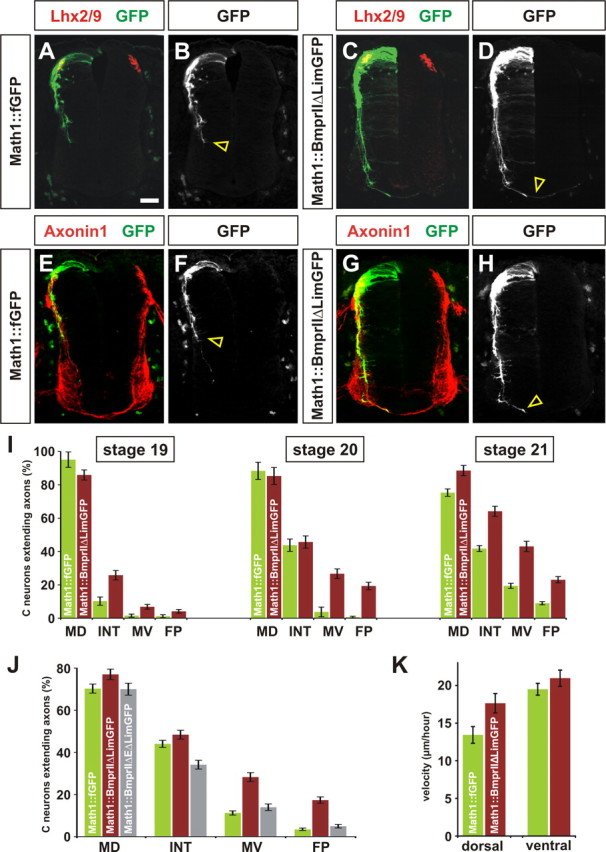Figure 5.

Reducing Limk1 activity by truncating BmprII results in accelerated axon growth. A–K, To assess whether Limk1 functionally interacts with BmprII in commissural neurons, a truncated BmprII construct was generated under the control of the Math1 enhancer (green, Math1:: BmprIIΔLim–GFP) in which the Limk1 binding site on the intracellular tail of BmprII was replaced with GFP. Commissural neurons were labeled with antibodies against Lhx2/9 (red, A, C) or Axonin1 (red, E, G). Commissural neurons electroporated with full-length BmprII project axons in a similar manner to control GFP+ axons (data not shown). A, B, E, F, Chick neurons electroporated with a control Math1::fGFP construct at HH stage 15 have extended GFP+ axons into the intermediate spinal cord by HH stage 20. C, D, G, H, In contrast, many commissural neurons electroporated with Math1::BmprIIΔLim–GFP have extended axons to the FP (arrowhead, D, H) by HH stage 20. I, Axon outgrowth was quantified as follows. For HH stage 19, 95 ± 4.6% commissural neurons expressing Math1::fGFP extended axons, of which 10% had projected to the INT line (n = 90 sections from 5 embryos). A similar number, 86 ± 3.0% (p > 0.05, Student's t test) of commissural neurons expressing Math1::BmprIIΔLim–GFP sections had extended axons, but ∼30% (p < 1.4 × 10−7) of these axons had reached INT line (n = 81 sections from 5 embryos). For HH stage 20, 88 ± 5.1% of commissural neurons expressing Math1::fGFP extended axons, with 4.5% of these axons projecting to the MV line (n = 52 sections from 4 embryos). A similar number, 85 ± 5.1% (p > 0.33) of commissural neurons expressing Math1::BmprIIΔLim–GFP have extended axons, but >32% (p < 2.6 × 10−11) of these had reached MV line (n = 51 sections from 4 embryos). For HH stage 21, 75.3 ± 2.2% of commissural neurons expressing Math1::fGFP extended axons, with 12% of these axons projecting to the FP (n = 74 sections from 5 embryos). In this experiment, 88.6 ± 3.0% of commissural neurons expressing Math1::BmprIIΔLim–GFP had extended axons, but >26% (p < 1.4 × 10−13) of these had reached FP (n = 42 sections from 3 embryos). J, To assess whether endogenous BMP binding was required for accelerated axon growth, a construct lacking both the extracellular domain and Lim binding domain (Math1:: BmprIIΔEΔLim–GFP) was electroporated into commissural neurons. By HH stage 21, there was no significant difference between extent of outgrowth of control GFP+ axons (n = 114 sections from 7 embryos) compared with BmprIIΔEΔLim–GFP+ axons (n = 97 sections from 5 embryos) at either the MV (p > 0.057) or FP (p > 0.066) lines. K, The rate of growth of electroporated axons was directly determined by imaging live cultures as they extended through either the dorsal (HH stage 19) or ventral (HH stage 21) spinal cord. In the dorsal spinal cord, axons electroporated with Math1::fGFP have a velocity of 13.4 ± 1.1 μm/h (n = 28 neurons), whereas axons electroporated with Math1::BmprIIΔLim–GFP grow significantly faster (p < 0.018) with a velocity of 17.6 ± 1.3 μm/h (n = 31 neurons). In contrast, there is no significant difference between the rate of growth (p < 0.26) in the ventral spinal cord; the control GFP+ axons have an average velocity of 19.5 ± 0.8 μm/h (n = 64 neurons), whereas the BmprIIΔLim–GFP+ axons have a velocity of 21.0 ± 1.1 μm/h (n = 45 neurons). Scale bar: A–H, 40 μm.
